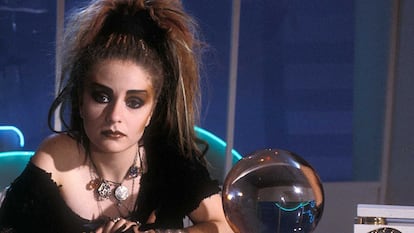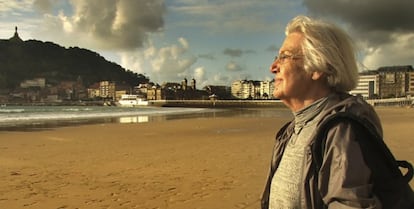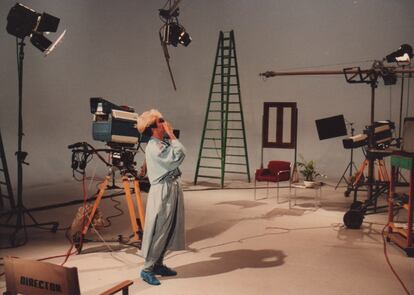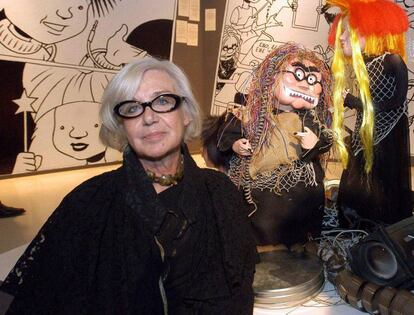For four years, from 1984 to 1988, Spain led television modernity. On October 6, 1984, the first program of The crystal ball, and Saturday mornings became an explosion of freedom, culture and education. And the oasis emerged from a curious soul, that of Lolo Rico (Madrid, 1935-San Sebastián, 2019), the creator of the phenomenon, but also a writer, editor, worker in other television formats and a woman who, in addition to a journey that She led Opus Dei to audiovisual anarchy and was the mother of seven children. The sixth of them, Miguel Alba Rico, is the co-director of Lolo’s powers, documentary present at the San Sebastián festival, and which shows a more human side of Rico, which goes beyond, although without forgetting her, The crystal ball.
Lolo’s powers It is titled that way because her children thought for a time that their mother was omnipotent. “It’s hard for me to say it,” confesses Miguel Alba Rico before one of the film’s screenings. “We are three directors of the documentary. One of them, Nino Fontán, with whom I work on TV, in Diary of…, He found out who my mother was three years after we were on the show together. I’m ashamed because I never know what to tell, because you have good and bad memories of your parents, and for others your mother is a myth. This is being an education for me to know say things about her.”
Alba Rico defends that her mother—buried in San Sebastián, a city she adored, in a tomb adorned with a crystal ball—was many things. “That’s why, for a while, I almost hated The crystal ball, because she ate my mother and it seems to me that she contributed many other things, for example, in literature, as a writer and as director of collections at the Bruguera publishing house.”
The Rico family moved from Madrid to San Sebastián due to the Civil War, and in her youth Lolo Rico enjoyed the varied readings that her father’s library allowed her (“At the age of 11 she already read Psychopathology of everyday life, by Sigmund Freud, and The capital, of Marx”, remembers her son), and ended up marrying the businessman Santiago Rico. He belonged to high society—“The people who were in Opus Dei were those who enjoyed the cultural movements that Francoism allowed”—and at the age of 40 he separated. She was left with seven children and a huge house in Madrid, in the Conde de Orgaz park, but her husband left her bank account empty and took the furniture. “We children were a driving force, because he had to get us ahead financially. What’s more, he started writing for us The stories of measles, which later became a book, and from children’s works it went to the radio. I feel very proud of my mother, because of course she was full of imperfections, but she was very curious, open, she refused to stay with an abusive husband and defended her ethics above all else,” explains Alba Rico.

His jump to television came with The white kite, and on October 6, 1984 he debuted The crystal ball. It started with 100,000 spectators. “When it was finished four years later, it had five million and only one and a half million were children,” notes his son. “My mother was free as much as she could. There are two very revealing stories. In the toughest moments of terrorism, he overtook a Civil Guard checkpoint in Madrid with his car. The civil guard told her: ‘Madam, you’re lucky we didn’t shoot you.’ And she replied: ‘No, you were lucky that I didn’t run over you.’ Another, when he once entered the office of the director of TVE and kicked out the visitor he was meeting with to tell him off.”

What did it feed on? The crystal ball? “From his curiosity, like when he saw a woman on the street who caught his attention, and later, when describing her at home, my sisters told him it was Alaska. They took her, at almost 50 years old, to Rockola and there she signed more people. “He took Pedro Reyes and Pablo Carbonell out of Retiro Park.” Many people passed by his house, and they lived there for some periods until Quique San Francisco. “We had a custom-made round table, two meters in diameter, and sometimes we had up to 25 people for dinner. For me, for example, Rosa Chacel was like my grandmother.”
On screen, Loquillo, Kiko Veneno, Javier Gurruchaga and Pablo Carbonell pay tribute to Rico. “I really liked the curtains, the ‘Yes, read’ ones. He doesn’t read’ or ‘Not alone, yes with friends’. My brother Santiago (a well-known philosopher) was the scriptwriter, and they created a world of originality, freedom, reflections and irony. My mother, above all, wanted to have fun. As he grew older, he eliminated the things that bored him. And that is already seen in the program. I considered that it had to entertain everyone. Hence many crazy things, like including concerts.”

The program was born at a very specific moment “Both Loquillo and my brother Santi explain it,” notes the filmmaker. “We come from the dictatorship, there is a vacuum of norms and my mother takes advantage of that to make the program. When democracy begins to impose other norms, that freedom is no longer allowed and the program ends.” After a first clash over the NATO referendum, a new call for attention by a gag on private education causes Lolo Rico to close The crystal ball. “And he stayed true to his spirit. She was appointed head of TVE’s children’s and youth programs department, and she only lasted six months. My mother was a member of the PCE (Communist Party of Spain) for a time, but she did not want to be pigeonholed into any political scheme. It did not sacralize anything, and they even mocked the Movida, which had found a place in The crystal ball.”

In a few days it will be forty years since the first broadcast. Alba Rico explains on this anniversary: “My mother continued working, did many other things, and returned to San Sebastián, which she adored. Still, it is true, there are many children of The crystal ball, and of course, if you take all the sections of the program, that mixed bag, its irreverence, its humor… From the sum of all the parts of The crystal ball only one thing stands out: my mother”.

